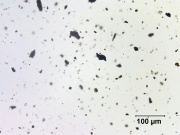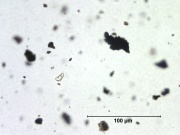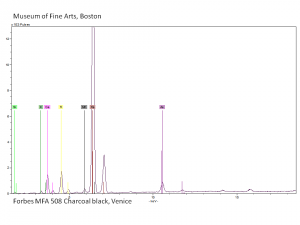Difference between revisions of "Charcoal black"
| Line 2: | Line 2: | ||
== Description == | == Description == | ||
| − | A black pigment prepared from the porous black residue left on the oven walls after the destructive distillation of wood. Charcoal black has been used as a pigment and writing tool since ancient times. The best charcoal black is produced from [ | + | A black pigment prepared from the porous black residue left on the oven walls after the destructive distillation of wood. Charcoal black has been used as a pigment and writing tool since ancient times. The best charcoal black is produced from [[willow]], [[basswood]], [[beech]], [[birch]], [[maple]], or other even-textured wood (Gettens and Stout 1966). The residue is ground then washed to removed an potash. Charcoal contains about 80-98% carbon with some ash and moisture. The gray-black powder is porous and light, but it has poor covering properties and is seldom used in paints. Charcoal black has been used for preliminary sketches, cartoons, pouncing, and underdrawings (Ellis 1999). It produces a soft, easily smudged drawing that is often sprayed with a fixative to prevent smears. Charcoal black was also used as a pigment in English house paints. |
| − | See also [ | + | See also [[carbon black]], [[charcoal]], and [[charcoal crayon]]. |
[[File:48_Charcoal_black_500X.jpg|thumb|Charcoal black]] | [[File:48_Charcoal_black_500X.jpg|thumb|Charcoal black]] | ||
| + | |||
== Synonyms and Related Terms == | == Synonyms and Related Terms == | ||
Revision as of 19:51, 12 January 2014
Description
A black pigment prepared from the porous black residue left on the oven walls after the destructive distillation of wood. Charcoal black has been used as a pigment and writing tool since ancient times. The best charcoal black is produced from Willow, Basswood, Beech, Birch, Maple, or other even-textured wood (Gettens and Stout 1966). The residue is ground then washed to removed an potash. Charcoal contains about 80-98% carbon with some ash and moisture. The gray-black powder is porous and light, but it has poor covering properties and is seldom used in paints. Charcoal black has been used for preliminary sketches, cartoons, pouncing, and underdrawings (Ellis 1999). It produces a soft, easily smudged drawing that is often sprayed with a fixative to prevent smears. Charcoal black was also used as a pigment in English house paints.
See also Carbon black, Charcoal, and Charcoal crayon.
Synonyms and Related Terms
Pigment Black 8; CI 77268; Pflanzenschwarz (Deut.); noir de charbon de bois (Fr.); carboncillo (Esp.); nero di carbone (It.); negro de carvão (Port.); charcoal grey; peach black; vegetable black; vine black; birch black; blue black; soft black; willow black; beech black
Other Properties
Particles are small, elongated and splintery
ASTM (1999) lightfastness = I (excellent)
| Refractive Index | opaque |
|---|
Additional Information
° J.Winter, "The Characterization of Pigments Based on Carbon" Studies in Conservation 28:49-66, 1983. ° M.Holben Ellis, "Charcoal (Wood and Vine)" in Media and Techniques of Works of Art on Paper, New York University Conservation Center of the Institute of Fine Arts, New York, 1999.
Authority
- R. J. Gettens, G.L. Stout, Painting Materials, A Short Encyclopaedia, Dover Publications, New York, 1966
- Ralph Mayer, A Dictionary of Art Terms and Techniques, Harper and Row Publishers, New York, 1969 (also 1945 printing)
- Art and Architecture Thesaurus Online, http://www.getty.edu/research/tools/vocabulary/aat/, J. Paul Getty Trust, Los Angeles, 2000
- R. Newman, E. Farrell, 'House Paint Pigments', Paint in America , R. Moss ed., Preservation Press, New York City, 1994
- Monona Rossol, The Artist's Complete Health and Safety Guide, Allworth Press, New York, 1994


